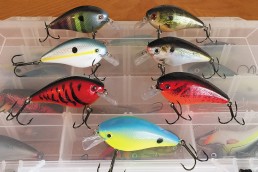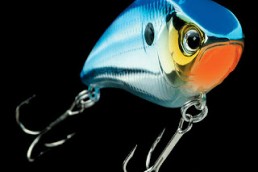Vibration Attracts Bass
SHARE THIS POST
An overlooked feature of bass fishing
Bait colors stand out as you walk the aisles of the tackle shops. The number of color selections is enormous. But the vibration and sound of baits are not standout features. We often don’t give these factors much thought and we should. Vibration attracts bass. So, let’s look at sound and vibration a little more in depth. This often-overlooked attribute of bass baits can have more impact on your catch ratios, than selecting the “perfect” bait color.
I’m not a fisheries biologist, nor am I quoting from a study. I’m just giving you my take on the subject based on trial and error, a basic knowledge of fish anatomy, and whole lot of years spent with rod and reel in hand. So with that disclaimer, let’s take a look at the importance of vibration and sound.
Vibration attracts bass by imitating prey
All baits—and natural prey that move through the water column—emit some type of sound or vibration. That’s whether they create a surface disturbance, crawl along the bottom or move at any depths in between. Bass and most other predators are highly sensitive to these sounds. These sounds and vibrations, whether created by natural forage or your bait trying to replicate natural forage, are one of the key components that trigger bass to strike.
I firmly believe that the vibration broadcast from your bait has more influence on whether a bass engages it than a chosen color pattern does. Before getting into bait choices, we first must understand how are bass home in on a bait, often long before they see it.
Once again, not too scientific here, but bass can sense sound and vibration. They accomplish this through ears located to the rear of their eyes, above the gill plate and through another sensory mechanism called the lateral line. This is a system of tactile sense organs located in the head and along both sides of the body, used to detect movement and vibration in the surrounding water. The lateral line, a fascinating mechanism, is more crucial to the detection of sound and vibration than the ear. In water without visibility, the lateral line is the organ that puts food in their bellies.
Lateral lines–a matter of life and death
I remember reading a piece from the late Doug Hannon (The Bass Professor), who, in my opinion, was the greatest big bass angler of all time, an incredible tackle innovator and researcher. He wrote about catching many older bass in the 10-pound range that had no eyesight. These visually impaired creatures, totally unable to see their targets, had survived to reach trophy proportions. How? By using their lateral lines.
An angler’s first reaction might be to appeal to that lateral line with the nosiest of baits on the market. That might sound logical, but it’s not that simple.
Yes, when you’re fishing waters with low visibility, a bait with increased sound and vibration might be the ticket. But, at certain times, a more subtle or quiet approach might be more productive. When it comes to clearer water, I’ve found that too much sound often spooks bass rather than draws their interest. As we look at a few baits, here, to understand the vibration factor, keep in mind that none of these suggestions are foolproof. Fish will make a fool of you if you are not willing to experiment.
Are you enjoying this post?
You can be among the first to get the latest info on where to go, what to use and how to use it!
Click here to see how swimbaits can help you catch fish all year long!
Subsurface presentations
When it comes to vibration and sound and having a variety of performers from noisy to subtle, the bait type that covers that whole spectrum of vibration is crankbaits. From lipless rattling cranks, to shallow cranks on down to the bottom dredgers, they offer the bass angler a huge selection of sound producers. Crankbaits produce vibration, vibration attracts bass. Simple.
It’s impossible to tell you which version crankbait to throw and when, but I will toss out a few suggestions. For my approach, the clearer the water I’m fishing, the less I rely on sound. Most cranks have noisy rattle chambers, but there are a few “silent” baits, many made of pure balsa. For the most part, I like baits with a little less sound coming from built-in sound chambers. Bass have no problem hearing and sensing the wobble of a crankbait. The sound produced by rattling trebles is more than enough sound for most waters.
Another aspect to keep in mind is the thinner the lure’s body, the less the vibration it usually emits. The fatter or wider-bodied baits have a bit more wobble and produce more vibration. The diving lip plays a part in vibration too, so consider all these factors. If you have a vibrating bait, you can feel the vibration through your rod. This is a simple way to actually feel the difference in vibration levels of various baits. The more rod thump, the greater the vibration output of that bait. Easy test.
Spinnerbaits–dial in your vibration intensity
Jump to spinnerbaits, another great style of bait that runs the gamut of vibration output. Blade style helps determine the amount of vibration produced. The rounder the blade, the more thump it creates in the water. Thinner, narrower blades create less vibration. Either can be a great choice, depending on the water conditions.
Jigs and plastics that move along or contact the bottom also create sound and vibration. Whether or not they have rattles, bass can sense these bottom intruders and their vibration attracts bass in. If they can sense a crawfish walking on the bottom, they can sense your bait. Personally, I don’t often use jigs with rattles. Bass can find a jig bumping bottom or off wood and rock without much added sound. Heavily stained water might give the rattling jigs a bit of an advantage. Like always, experiment.
Other bottom baits like worms and creature baits create some sound and vibration when worked on the bottom, too. Keep in mind, the thicker or heavier the plastic body, the more water it displaces, which creates more sound. Although one might think that soft plastics are silent, this bait’s vibration attracts bass despite how small it is.
My hopes are that these concepts would shed a bit of light. I also hope you realize that bass use a hunting mechanism beyond sight to locate their prey. Vibration attracts bass, so appeal to a bass’ natural instincts. Use a bait with strong vibration. Next time when you’re wandering the tackle aisles, look a little deeper than the colorful paint schemes. Pay attention to bait designs, and aw heck, shake a few baits and keep the vibration factor in mind this season on the bank.
MWO
SHARE THIS POST
Did you enjoy this post?
You can be among the first to get the latest info on where to go, what to use and how to use it!
Dan Brozowski
Passion for angling drives Dan Brozowski to the water’s edge virtually any chance he gets. Although passion cannot be measured, weighed, or recorded, it can be shared. He does this through his writing and while on the water. If you have any questions or comments for Dan, you may contact him at: onthebank@att.net.



